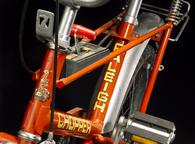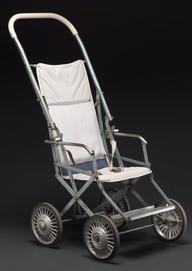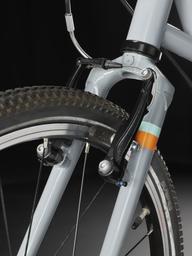

Hooded phaeton
- Made:
- 1800-1825 in unknown place

This hooded phaeton was built approximately between 1800-1825, before it was acquired and used by Tilling Ltd. A four wheel, four seat carriage designed to be pulled by one or two horses.
The carriage has entirely black paintwork and its seats are covered with dark blue padding. The front seats can be covered by a foldable black leather hood and protected from upturned mud and stones by a black leather dash. The driver’s seat includes a foot pedal that controls the carriage’s spoon brakes (the mechanism for which can be clearly seen).
The back seats (often called rumble seats) have had their dark blue padding removed and have no hood to protect them from the elements and fitted underneath them is boot storage.
The main body of the carriage is separated and suspended from the undercarriage via elliptical springs. The wheels have brass hub caps which are engraved “T Tilling Ltd, Peckham”.
This hooded phaeton was owned by T. Tilling Ltd, famous coachbuilders and jobmasters (renters of horses and horse drawn vehicles). The company was founded in Peckham, London in 1847 by innovator Thomas Tilling. Tilling Ltd are renowned for helping to establish the modern bus services, notably by introducing the idea of set bus routes and bus stops, a system that made Tilling’s buses reliable and punctual. Tilling Ltd also rented out various coaches, cabs, and wedding carriages, including this hooded phaeton which was likely used as a rented leisure vehicle. Tilling continues today as part of British Tyre and Rubber Co Ltd, now under Invensys plc.
Details
- Category:
- Road Transport
- Object Number:
- 1938-498
- Materials:
- paint, metal (unknown), textile, wood (unidentified) and leather
- Measurements:
-
overall: 1950 mm x 960 mm x 2480 mm,
- type:
- phaeton
- credit:
- Russell, Gilbert




